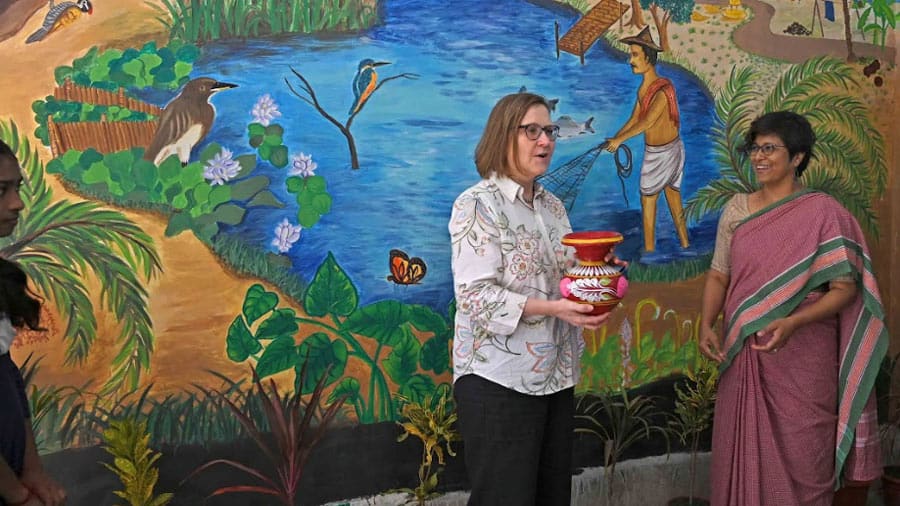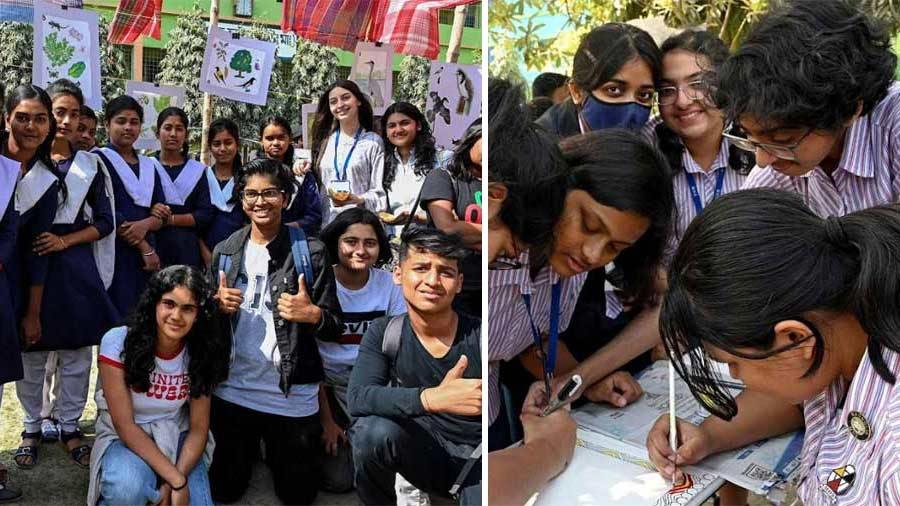Next time you drive down the EM Bypass, keep an eye on the vast green stretches flanking it and take a short detour onto Basanti Highway from Science City. Tucked behind New Town and Ruby More lies a massive area where the air is pure, trees grow in abundance, and nature comes alive. Welcome to the East Kolkata Wetlands, often referred to as the “lungs of the city”.
To commemorate the World Wetlands Day on February 2, Disappearing Dialogues Collective put together a unique celebration of Kolkata’s ecological hub with Jolabhumi Utsav ’23. My Kolkata was there.

The walk allowed city dwellers to get a more intimate look at the lives of those who live in the wetlands
Wetland walk
The event began with a walk through the wetlands, titled Paye Paye Jolabhumi, where students from two local schools, Bamanghata High School and Kheadaha High School, took people on a tour of their surroundings. The walk offered a rare insight into the lives of those who live within the wetlands. The students not only identified each tree and its unique properties, but also spoke about the local practices that emerged from being cut off from the bustle of Kolkata.

While (left) Mandira Das and Purba Munda drew a guava tree, (right) Kishan Mondal drew a dialogue between a dragonfly and a grasshopper. “This fair has been a great place for us to express the green diversity that surrounds us,” said the Class IX students of Bamanghata High School
Message through murals
Murals painted by the students along with Disappearing Dialogues founder-director Nobina Gupta were unveiled at both the schools. The murals also had the contributions of several artists, including Mahjabin Imam Majumdar Shweta P. Raina and Suman Ghosh.

The murals showed everyday practices and daily lives of those residing in the wetlands. (left) Astrid Wege, director, Goethe Institut, Kolkata, inaugurated the murals with Disappearing Dialogues founder-director Nobina Gupta. “The East Kolkata Wetlands are very important for Kolkata's ecosystem and ecological existence. This initiative for their sustainability is very impressive, and it is encouraging to see how much young kids know about their own environment. This local knowledge needs to be imparted, and education is the key to deal with climate change,” said Wege, while inaugurating the mural at Bamanghata
The murals were particularly significant for the headmasters of both schools, who had witnessed up close the involvement of over 300 students from Classes VI to XII. “Most students from our school come from a fishery or agricultural background, so they are directly involved in the conservation of the wetlands. Through this mural, our chief objective was to raise awareness about the value that this region holds for us,” said Manas Haldar, headmaster of Bamanghata High School. Altup Sekh, the headmaster of Kheadaha High School, echoed his sentiments. “The wetlands are responsible for purifying the water of the rest of the city, without spending hundreds of crores. The children you see here have actively been working to put together this event for the past year, and in doing so, they have created an entire culture around the area.”

(Right) Representatives from Birdwatchers’ Society shared the joys of birdwatching. The fair at Kheadaha High School had several interesting pop-ups. (right top) Disappearing Dialogues had its own initiative called DD Dokan selling tote bags, pillow covers, scrunchies and postcards made by women and children from the wetlands to help support the community. (bottom) Namita Naskar, whose daughter Nibedita studies in Class XII at Bamanghata High School, supported the cause by preparing pithe puli for the students with fresh gur sourced from her backyard.
Fun fair
Kheadaha High School hosted a fair with stalls selling food and handmade products. Fun games based on the environment, biodiversity, climate change and sustainability were organised. The fair also exhibited wetlands-influenced artwork, dance and music by the students, and received enthusiastic participation from several schools, including Modern High School for Girls, Calcutta International School, The Heritage School and Future Hope School.

The event also served as a bridge between students from city schools with students from Bamanghata and Kheadaha. (left) While students from Calcutta International School were amazed at the artistic exhibit by the locals, (right) students from Modern High School huddled together to create pattachitra artwork depicting human incursion on nature
Music and dance
The event concluded with a series of performances. A dance was choreographed by Odissi dancer Shashwati Garai Ghosh, who held a 10-day workshop with 32 kids on the jolabhumi concept. “To ensure authenticity, we not only used local props like tokris, gamchhas and fishing nets, but also rural instruments like dubki, dhol and tasha,” said Ghosh. There was also a musical performance titled Gane Golpe Jolabhumi. It comprised a session by Subhalaxmi, who told the story of the waning wetlands from the perspective of a little girl. This was complimented by original compositions from members of the Bengali band, Naiyor, which made listeners ponder about the implications of losing the wetlands.
“This event is a larger part of the vision we have for celebrating and preserving the wetlands. We divided it into three broad segments : 'understanding diversity through art’, ‘tracing connections through performance labs and trails’, and finally ‘reflecting through interaction and exhibition and generating awareness’,” signed off Nobina Gupta.
